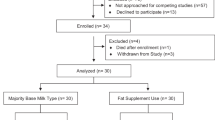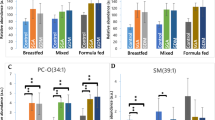Abstract
Infants need arachidonic acid (AA; C20:4n-6) for eicosanoid synthesis and deposition in growing tissues, including brain. Human milk supplies performed AA in amounts considered to meet accretion in membrane-rich tissues, but vegetable oil-based infant formulas do not contain AA. We studied two groups of ten healthy infants, each fed human milk or formula, and analyzed plasma lipid composition. Percentage contributions of AA to plasma phospholipids were stable over two months after birth in breast-fed infants, but infants fed formula developed significantly (P<0.05) lower levels at the ages of two weeks (formula 6.9% vs. breast 9.4%, w/w), one month (6.2 vs. 9.1%), and two months (5.7 vs 8.4%). In a second trial, we randomized infants to receive (from birth to age four months) formula without or with both AA and docosahexaenoic acid (DHA; C22:6n-3) at levels typical for mature human milk. Infants fed conventional formula showed a continuous decrease of phospholipid AA over time, whereas feeding of formula supplemented with AA and DHA led to significantly higher AA levels, similar to those in breast-fed infants (two months: supplemented 9.6% vs. unsupplemented 7.1%; four months; 8.7 vs. 6.6%). In order to estimate infantile capacity for endogenous synthesis of AA, we fed four term neonates with newly diagnosed phenylketonuria (mean age 18 d) a formula with all fat contributed by corn oil, which has a higher natural13C-enrichment than European human milk or formula. Analysis of13C-enrichment in plasma fatty acids over four days allowed us to estimate infantile AA synthesis. We found an increased13C-value in plasma AA of all infants, which indicates that term neonates can synthesize AA. However, with a simplified isotope balance equation, we estimate that endogenous synthesis contributed only about 23% of total plasma arachidonic acid by day four. We conclude that full-term infants fed formula may require a dietary supply of some preformed AA if the biochemical status of breast-fed infants is to be achieved.
Similar content being viewed by others
Abbreviations
- AA:
-
arachidonic acid (C20:4n-6)
- ALA:
-
α-linolenic acid (C18:3n-3)
- DGLA:
-
dinomo-γ-linolenic acid (C20:3n-6)
- DHA:
-
docosahexaenoic acid (C22:6n-3)
- GLA:
-
γ-linolenic acid (C18:3n-6)
- HM:
-
human milk
- LA:
-
linoleic acid (C18:2n-6)
- LC-PUFA:
-
long-chain polyunsaturated fatty acids
- %:
-
per thousand
References
Uauy, R., Birch, D.G., Birch, E.E., Tyson, J.E., and Hoffman, D.R. (1990) Effect of Dietary Omega-3 Fatty Acids on Retinal Function of Very-Low-Birth-Weight Neonates,Pediatr. Res. 28, 485–492.
Carlson, S.E., Werkman, S.H., Rhodes, P.G., and Tolley, E.A. (1993) Visual-Acuity Development in Healthy Preterm Infants: Effect of Marine-Oil Supplementation,Am. J. Clin. Nutr. 58, 35–42.
Carlson, S.E., Werkman, S.H., Peeples, J.M., and Wilson, W.M. (1994) Growth and Development of Premature Infants in Relation to n-3 and n-6 Fatty Acid Status, inFatty Acids and Lipids: Biological Aspects (Galli, C., Simopoulos, A.P., and Tremoli, E., eds.) pp. 63–69, S. Karger AG, Basel, 1991.
Kiletzko, B., and Braun, M. (1991) Arachidonic Acid and Early Human Growth: Is There a Relation?Ann. Nutr. Metab. 35, 128–131.
Leaf, A.A., Leighfield, M.J., Costeloe, K.L., and Crawford, M.A. (1992) Long-Chain Polyunsaturated Fatty Acids and Fetal Growth,Early Hum. Dev. 30, 183–191.
Carlson, S.E., Cooke, R.J., Werkman, S.H., and Tolley, E.A. First-Year Growth of Preterm Infants Fed Standard Compared to Marine Oil n-3 Supplemented Formula.Lipids 27, 901–907.
Aggett, P.J., Haschke, F., Heine, W., Hernell, O., Koletzko, B., Launiala, K., Rey, J., Rubino, A., Schöch, G., Senterre, J., and Tormo, R., Committee Report: Comment on the Content and Composition of Lipids in Infant Formulas,Acta Paediatr. Scand. 80, 887–896.
Decsi, T., and Koletzko, B. (1994) Polyunsaturated Fatty Acids in Infant NutritionActa. Paediatr. Suppl. 395, 31–37.
Koletzko, B., Thiel, I., and Abiodun, P.O. (1991) Fatty Acid Composition of Mature Human Milk in Nigeria,Z. Ernährungwiss 30, 289–297.
Koletzko, B., Thiel, I., and Abiodun, P.O. (1992) The Fatty Acid Composition of Human Milk in Europe and Africa,J. Pediatr. 120, S62-S70.
Koletzko, B., and Bremer, H.J. (1989) Fat Content and Fatty Acid Composition of Infant Formulae,Acta Paediatr. Scand. 78, 513–521.
Decsi, T., Behrendt, E., and Koletzko, B. (1994) Fatty Acid Composition of Hungarian Infant Formulae Revisited,Acta Paediatr. Hung. 34, 107–116.
Farquharson, J., Cockburn, F., Patrick, W.A., Jamieson, E.C., and Logan, R.W. (1992) Infant Cerebral CortexPhospholipid Fatty-Acid Composition and Diet,Lancet 340, 810–813.
Makrides, M., Neumann, M.A., Byard, R.W., Simmer, K., and Gibson, R.A. (1994) Fatty Acid Composition of Brain, Retina, and Erythrocytes in Breast- and Formula-fed Infants,Am. J. Clin. Nutr. 60, 189–194.
Makrides, M., Simmer, K., Goggin, M., and Gibson, R.A. (1993) Erythrocyte Docosahexaenoic Acid Correlates with the Visual Response of Healthy, Term Infants,Pediatr. Res. 34, 425–427.
Jorgensen, M.H., Jonsbo, F., Holmer, G., Hernell, O., and Michaelsen, K.F. (1994) Breast-Fed (BF) Term Infants Have a Better Visual Acuity Than Formula Fed (FF) Infants at the Age of 2 and 4 Months,FASEB J. 8, 460 (Abstract).
Innis, S.M., Nelson, C.M., Rioux, M.F., and King, D.J. Development of Visual Acuity in Relation to Plasma and Erythrocyte Omega-6 and Omega-3 Fatty Acids in Healthy Term Gestation Infants,Am. J. Clin. Nutr. 60, 347–352.
Makrides, M., Neumann, M., Simmer, K., Pater, J., and Gibson, R. (1995) Are Long-Chair Polyunsaturated Fatty Acids Essential Nutrients in Infancy?,Lancet 345, 1463–1468.
DeLucchi, C., Pita, M.L., Faus, M.J., Molina, J.A., Uauy, R., and Gil, A. (1978) Effects of Dietary Nucleotides on the Fatty Acid Composition of Erythrocyte Membrane Lipids in Term Infants,J. Pediatr. Gastroenterol. Nutr. 6, 568–574.
Putnam, J.C., Carlson, S.E., DeVoe, P., and Barness, L.A. (1982) The Effect of Variations in Dietary Fatty Acids on the Fatty Acid Phosphatidylethanolamine in Human Infants,Am. J. Clin. Nutr. 36, 106–114.
Olegard, R., and Svennerholm, L. (1971) Effects of Diet on Fatty Acid Composition of Plasma and Red Cell Phosphoglycerides in Three-Month-Old Infants,Acta. Paediatr. Scand. 60, 505–511.
Ponder, D.L., Innis, S.M., Benson, J.D., and Siegman J.S. (1992) Docosahexaenoic Acid Status of Term Infants Fed Breast Milk or Infant Formula Containing Soy Oil or Corn Oil,Pediatr. Res. 32, 683–688.
Decsi, T., Thiel, I., and Koletzko, B. (1998) Essential Fatty Acid Status in Full-Term Infants Fed Breast Milk or Formula,Arch. Dis. Childh. 72, F23-F28.
Decsi, T., and Koletzko, B. (1995) Growth, Fatty Acid Composition of Plasma Lipid Classes, and Plasma Retinol and Tocopherol Concentrations in Full-Term Infants Fed Formula Enriched with Long-Chain Polyunsaturated Fatty Acids,Acta. Paediatr. 84, 725–732.
Nakamkura, K., Schoeller, D.A., Winkler, F.J., and Schmidt, H.-L. (1982) Geographical Variations in the Carbon Isotope Composition of the Diet and Hair of Contemporary Man,Biomed. Mass. Spectrom. 9, 390–394.
Koletzko, B., Schmidt, E., Bremer, H.J., Haug, M., and Harzer, G. (1989) Effects of Dietary Long-Chain Polyunsaturated Fatty Acids on the Essential Fatty Acid Status of Premature Infants,Eur. J. Pediatr. 148, 669–675.
Decsi, T., and Koletzko, B. (1994) Fatty Acid Composition of Plasma Lipid Classes in Healthy Subjects from Birth to Young Adulthood,Eur. J. Pediatr. 153, 520–525.
Demmkkelmair, H., v. Schenck, U., Behrendt, E., Sauerwald, T., and Koletzko, B. (1995) Estimation of Arachidonic Acid Synthesis in Full-Term Neonates Using Natural Variation of 13-C Content,J. Pediatr. Gastroenterol. Nutr. 21, 31–36.
Craig, H. (1957) Isotopic Standards for Carbon and Oxygen and Correction Factors for Mass Spectrometric Analysis of Carbon Dioxide,Geochim. Cosmochim. Acta 12, 133–149.
Koletzko, B. (1992) Fats for Brains,Eur. J. Clin. Nutr. 46, S51-S62.
Koletzko, B., Thiel, I., and Springer, S. (1992) Lipids in Human Milk: A Model for Infant Formulae?,Eur. J. Clin. Nutr. 46, S45-S55.
Ostrea, E.M., Balun, J.E., Winkler, R., and Porter, T. (1986) Influence of Breast-Feeding on the Restoration of the Low Serum Concentration of Vitamin E and Beta-Carotene in the Newborn Infant,Am. J. Obstet. Gynecol. 154, 1014–1017.
Poisson, J.-P., Dupuy, R.-P., Sarda, P., Descomps, B., Narce, M., Rieu, D., and Crastes de Paulet, A. (1993) Evidence that Liver Micoosomes of Human Neonates Desaturate Essential Fatty Acids,Biochem. Biophys. Acta 1167, 109–113.
Author information
Authors and Affiliations
Additional information
Based on a presentations at the AOCS Annual Meeting & Expo in San Antonio, Texas, May 7‐11, 1995.
About this article
Cite this article
Koletzko, B., Decsi, T. & Demmelmair, H. Arachidonic acid supply and metabolism in human infants born at full term. Lipids 31, 79–83 (1996). https://doi.org/10.1007/BF02522415
Received:
Accepted:
Issue Date:
DOI: https://doi.org/10.1007/BF02522415




